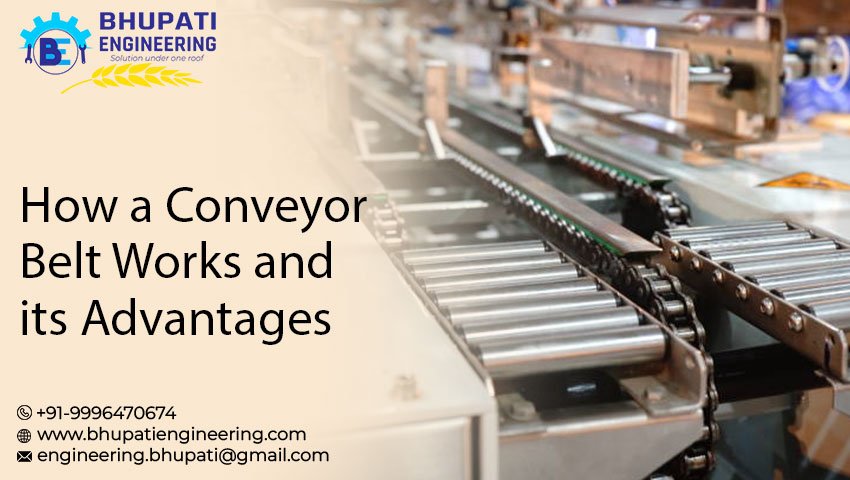Welcome to Bhupati Engineering
Welcome to Bhupati Engineering

A conveyor belt is like a moving road made of sturdy material, usually rubber or fabric, that transports things from one place to another. It's commonly seen in factories, airports, and supermarkets, helping to move items like boxes, luggage, or groceries smoothly and efficiently. Think of it as a magic carpet for objects, making tasks easier by eliminating the need for manual carrying over long distances.
Sure, here are the components of a conveyor belt explained in simple terms:
• Belt: This is the actual moving part of the conveyor, usually made of rubber or fabric, which carries items along its surface.
• Pulleys: These are wheels or drums around which the belt rotates, helping to drive its movement.
• Rollers: These are small wheels positioned along the belt's path, supporting and guiding it as it moves.
• Motor: This powers the conveyor belt, either electrically or mechanically, to keep it running smoothly.
• Frame: The framework that supports and holds all the components together, providing structure and stability.
A conveyor belt works by utilizing a motorized pulley system to move items along its surface from one point to another. The motor powers the pulleys, which, in turn, drive the belt forward in a continuous loop. As the belt moves, items placed on it are carried along, guided by rollers, and supported by the frame. The speed and direction of the conveyor belt can be controlled to suit the specific needs of the operation. Essentially, it functions as a reliable and efficient means of transporting goods or materials within various industries, streamlining processes, and enhancing productivity.
Certainly! Here are the uses and benefits of conveyor belts explained in simple terms:
1. Industrial Manufacturing: Conveyor belts are widely used in factories and manufacturing plants to transport materials and products along assembly lines, increasing efficiency and reducing manual handling.
2. Warehousing and Distribution: In warehouses and distribution centers, conveyor belts facilitate the movement of goods from storage areas to shipping docks, speeding up the process of inventory management and order fulfillment.
3. Mining and Quarrying: Conveyor belts are essential in the mining and quarrying industries for transporting raw materials like coal, ore, and aggregates, improving productivity and safety.
4. Agriculture: Farmers utilize conveyor belts for tasks such as harvesting crops, sorting produce, and loading/unloading equipment, making agricultural operations more streamlined and manageable.
5. Airports and Logistics: Conveyor belts play a crucial role in airports and logistics centers by handling luggage, parcels, and cargo, ensuring smooth and efficient baggage handling and freight transportation.
6. Benefits:
◦ Increased Efficiency: Conveyor belts automate material handling processes, reducing labor requirements and operational costs.
◦ Safety: They minimize the risks associated with manual handling, such as strain injuries.
◦ Versatility: Conveyor belts can be customized to fit various industries and applications, offering flexibility in operations.
◦ Continuous Operation: They enable continuous movement of materials, maximizing throughput and productivity.
We hope that this blog has helped you grasp the working principles and advantages of conveyor belts. As leading Conveyor Belt Manufacturers in India, we at Bhupati Engineering pride ourselves on delivering top-quality products tailored to your needs. With our dedication to innovation and customer satisfaction, you can trust us to provide reliable conveyor belt solutions that enhance efficiency and streamline operations across various industries.